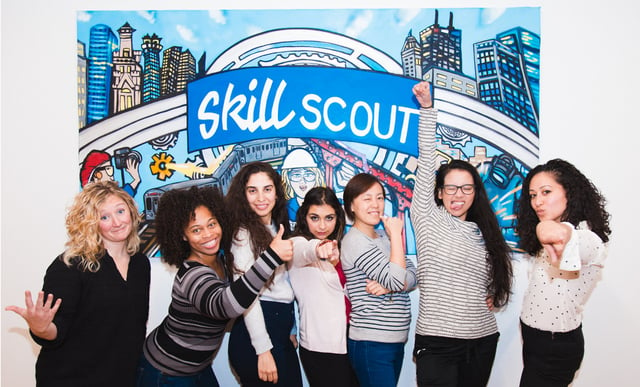Freelancers, Diversity and the Workforce of the Future.
Ask any talent acquisition pracitioner or leader out there what's top of mind at the moment, you'd likely be given some combination of three topics that have become so pervasive that they've become largely ubiquituous in TA today: diversity (of course), the gig economy (it's for real) and building talent pipelines.
Working for a startup in the HR technology industry, I've been privileged enough to get an inside look at dozens of diverse recruiting function. That hands on experience and frontline obervations have led me to believe these issues are not only interconnected, but are, in fact, among the most crucial components in not only influencing how recruiting happens today, but shaping the future of our workforce, too.
My team and I are storytellers, helping build better employer brands through better video content; after all, telling stories is what we do.
We thought it only fitting, then, that given the breadth and depth of company cultures and work enviroments we've been seen, it made sense for us to share our story of how we actually built a new kind of workforce inside our own company here at SkillScout. It hasn't been easy.
But it works. And it can for you, too.
First Things, First: A Recruiting Reality Check.
.png?width=225&height=225&name=download%20(1).png) Let's go ahead and check our privilege here. SkillScout is a four year old startup trying to build a scalable team - and a sustainable buisness - in a totally greenfield environment, where the only known, really, is the unkonwn.
Let's go ahead and check our privilege here. SkillScout is a four year old startup trying to build a scalable team - and a sustainable buisness - in a totally greenfield environment, where the only known, really, is the unkonwn.
We don't have a ton of historic struggles, legacy issues, industry regulations or really, any of the things that most corporations have to deal with holding us back. Which is nice, I know.
This means we can easily build a team from scratch, creating headcount and hiring candidates however we want to. I get it. You probably face a ton of complex conditions and challenges when it comes to building your team, and don't have the luxury of having little to no restrictions when it comes to recruiting and hiring.
No matter what limitations or restrictions you or your company happen to face when it comes to attracting, engaging and hiring top talent, however, I hope you can take some of these tactics and strategies and actually put them into action as you build your own workforce of the future.
My co-founder and I founded our company after we happened to work together on a project dedicated to helping formerly incarcerated youth transition out of the prison system and into the job market. Through the research we conducted during this project, we saw a constant (and somewhat troubling) theme emerge again and again: huge amounts of companies were eliminating huge segments of talent through their existing hiring processes.
There existed a pervasive paradox that while companies were struggling to attract and convert diverse talent and build inclusive teams, retain workers and help untapped talent reach its true potential. What we heard loud and clear was this:
You cannot be what you cannot see.
Put another way, lack of exposure to jobs limits career possibilities.
We thought this was a problem that we could fix, so we started filming jobs. Our videos featured an authentic preview of jobs and a realistic depiction of real workplaces and workers, and the rest, as they say, is history.
Here's ours.
An Inclusive Approach To Diversity Recruiting.
.png?width=301&height=301&name=diversity-hiring%20(1).png) First, we realized early on that if we were going to use videos to help companies attract diverse talent, it was imperative for us, as a company, to practice what we preach.
First, we realized early on that if we were going to use videos to help companies attract diverse talent, it was imperative for us, as a company, to practice what we preach.
We use video to capture jobs and communicate with candidates, giving them a (paid) project so employers can see a real work sample instead of relying simply on gut feeling and that ever elusive concept of "fit."
For us, it doesn't matter if candidates went to elite film schools or are self taught; pedigree doesn't matter nearly as much as the person and their potential, and when making hiring decisions, it's my experience that's what you should really focus on.
Fun fact: our fastest editor is 20 years old, and is completely self-taught, training himself to edit on his iPhone. How could you ever pass up hiring someone with that sort of professional passion? We hire videographers and editors - and rather than having them fill out some onerous application or providing some fancy portfolio, we have candidates film and edit a video of themselves entitled, Meet Your Editor.
We pay them for their time, and the product we end up getting for this investment has an immediate impact and an optimal recruiting ROI. We get to see not only how they edit but we can work with them on a real project in real time - collaborating on creative, providing feedback, and learning whether or not we click with the candidate (and vice versa) when we're working together.
Those soft skills are hard to assess. This experiential approach makes screening and selection imminently easier, from my experience. The results reinforce this - the film and media industry, like so many others, is heavily skewed towards males.
Whether we're talking feature films or broadcast media, where women make up only 7% and 33% of the roles in these industries, respectfully, the gender diversity gap in the entertainment and media industries is endemic, and widening. As bad as those numbers are, representation for women of color is even lower.
Which is a pretty sad, a pretty big problem.

Our team makeup is:
70% female
80% people of color
85% creative freelancers
We've gotten to these numbers and truly moved the needle on diversity by looking outside traditional sources of talent in our industry; I encourage any recruiter or talent organization to at least try a similar strategy.
Remove barriers that unnecessarily shut candidates out of your hiring process, or might preempt them from entering into your talent funnel.
Does your company use knockout criteria that isn't in any way predictive of performance relative to the job you're hiring? Do you require a college degree to get a foot in the door? How about reviewing resumes? Criminial background or credit checks?
When it comes to screening candidates, there are obviously a ton of obstacles and barriers companies in their hiring process that can preempt top talent from even getting a look.
For candidates, similarly, using videos allows them to see beyond static job descriptions and actually get an authentic preview of the job they're considering - allowing them to self-select in or out of applying armed with the information they need to make an informed decision.
Work samples reduce bias in hiring and are the single best predictor of performance on the job.
The Gig Economy: Believe The Hype.
When we founded our company, we never would have imagined the impact the gig economy would have on our business. We're poster children for gig-growth with no signs of slowing down. 85% of our workforce is comprised of a group of 50+ loyal freelancers. Many of them have worked with us from the beginning, and prefer to remain freelance.
Our team loves the flexibility of freelancing because they can pursue passion projects. We love their passion projects too. Whether that’s filming a documentary at Standing Rock, capturing wedding celebrations, or debuting a film about sexual harassment in Egypt -- they’re coming back to work infused with ideas that influence the way we tell stories.
Our most creative ideas have come from outside the HR industry, which is how we are different from your average corporate video agency.
From HR To Chief Human Storyteller | Abby Cheesman | DisruptHR Talks from DisruptHR on Vimeo.
7 Ways To Get the Most Out of Your Freelancers.
Here are a few ways we've been able to work with freelancers to drive business outcomes and build a loyalty team:
1. Invest in your freelancers.
Often, companies hesitate to invest resources in freelancers at the same level as they would a full time employee. Freelancers feel that, and are paying attention! They know when a company is thoughtful about onboarding and training for freelance staff. We spend the same time and energy training freelance editors as we do our full time staff.
2. Respect their outside commitments.
We want our freelancers to bring their whole selves to work. That means we need to create an environment where they can openly share other commitments they have going on. It’s a bit of a dance, but our freelancers appreciate the empathy we demonstrate in scheduling projects and allowing them to balance other work.
3. Encourage them to share what they’re learning on other projects.
This has been one of the most rewarding experiences working with freelancers. They always have something new to share- techniques or even new offerings we should pursue, like our new 360 video feature.
4. Host team work sessions.
We host a half-day monthly check in for our entire team to calibrate, share best practices, and explore ways we can improve. We make it an event. We bring in lunch and provide time to catch up. And, because we're a media company, we turn the camera on ourselves to film content to share with our community.
5. Leverage their strengths.
We use each of our team members’ super powers. We engage freelancers in what they are highly skilled or interested in, and don’t expect them to perform every duty that would be expected from a full time employee.
For example, we have a skilled producer who has built our 360 video practice, but despises editing. We can use her skills and passion, and not force her role to include editing.
6. Treat them like insiders.
Our "freelancers" have been integral to building our business and shaping the culture. We celebrate them at holiday parties, honor their birthdays, and highlight them on our social media every chance we get.
7. Make "Talent Community" More Than A Buzzword.
Last year, we helped launch Mezcla Media Collective, a hub for women of color and allies behind the camera. The community has already allowed us to build relationships with other women, host events, and created a new pipeline of talent for our organization.
We started Mezcla because of our own challenges finding, and building relationships with other women of color in our industry. If you cannot see the community, BE the community. We kicked off with a series of meetups, and grew to 200+ active members in two months.
We’ve hired five new videographers, editors and photographers from Mezcla already.

Whether you’re hiring engineers, call center reps, or research scientists you can build a community. A few ideas to start: sponsor a meetup, host events around a relevant topic, invite schools for tours, or donate space to local groups.
Don’t make it a pitch for your own company - ask not what the candidate can do for you, but what you can do for the candidate. Be there to help, and be genuine, and you'll quickly make connections, convert candidates, and become a critical and central component of the community in which you and your employees work - and live.
"Talent community" shouldn't be a buzzword, after all - it should be how every employer approaches recruiting and hiring.
To learn more about our sponsor SkillScout or to hear more about their diversity journey and freelance strategies from speaker Abby Cheesman in person, click here to learn more and to register for TalentNet Live in Austin, TX on March 9.
-min.png)




